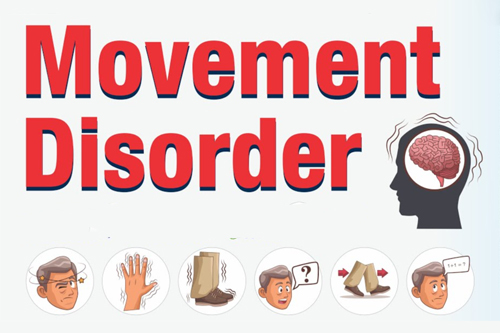
Movement disorders
Movement disorders affect the nervous system and cause involuntary or abnormal body movements. These conditions can impact mobility, coordination, and daily activities. Over the years, medical advancements have significantly improved diagnosis and treatment options, offering better outcomes for patients. Moreover, with ongoing research, new therapies continue to emerge, bringing hope to individuals facing these challenges.
Common Types of Movement Disorders:
1. Parkinson’s Disease
Parkinson’s disease results from the loss of dopamine-producing brain cells. This leads to tremors, muscle stiffness, and slow movement. Besides motor symptoms, patients often experience cognitive changes, sleep disturbances, and mood disorders. Although there is no cure, medications, physical therapy, and deep brain stimulation (DBS) help manage symptoms effectively. 2. Essential Tremor
Essential tremor causes rhythmic shaking, primarily in the hands. Unlike Parkinson’s disease, this condition does not lead to other neurological issues. However, the tremors can worsen over time, making daily tasks difficult. Doctors often recommend beta-blockers, anti-seizure medications, and focused ultrasound therapy for symptom relief.y. 3. Dystonia
Dystonia causes involuntary muscle contractions, leading to repetitive movements or abnormal postures. These symptoms can affect a single muscle group or spread throughout the body. Botox injections, physical therapy, and deep brain stimulation provide effective relief for many patients. 4. Huntington’s Disease
This inherited disorder damages brain cells, leading to uncontrolled movements, emotional instability, and cognitive decline. Symptoms typically appear in adulthood and progress over time. While no cure exists, medications can help control symptoms, and genetic counseling supports affected families. 5. Tourette Syndrome
Tourette syndrome involves repetitive, involuntary movements and vocal tics. The severity of symptoms varies, with some individuals experiencing only mild tics. Behavioral therapy, medications, and lifestyle adjustments help manage the condition effectively. 6. Ataxia
Ataxia affects balance and coordination, often resulting from genetic conditions, stroke, or brain injuries. Individuals may struggle with walking, hand movements, and speech. Physical therapy, speech therapy, and assistive devices improve mobility and daily function. Diagnosis of Movement Disorders:
Accurate diagnosis plays a key role in determining the most effective treatment approach. Doctors use several diagnostic tools, including:
- Neurological Exams: Evaluating movement, reflexes, muscle strength, and coordination.
- Imaging Tests: MRI and CT scans detect brain abnormalities.
- Genetic Testing: Identifying inherited conditions like Huntington’s disease.
- Electromyography (EMG): Measuring electrical activity in muscles.
Treatment Options:
1. Medications
Many movement disorders respond well to medications. For instance, Parkinson’s disease patients benefit from dopamine-replacement therapy, while essential tremor patients often take beta-blockers or anticonvulsants. Regular monitoring ensures that medications remain effective and side effects stay minimal. 2. Physical and Occupational Therapy
Therapeutic exercises improve mobility, balance, and coordination. Moreover, occupational therapy teaches individuals adaptive techniques to perform daily activities with ease. These interventions enhance independence and overall well-being. 3. Deep Brain Stimulation (DBS)
DBS involves implanting electrodes in specific brain areas to regulate abnormal movement signals. This surgical procedure significantly reduces symptoms in Parkinson’s disease, dystonia, and essential tremor. Since DBS is adjustable, doctors can fine-tune stimulation levels based on patient needs. 4. Lifestyle Modifications
Regular exercise, a balanced diet, and stress management contribute to better symptom control. Additionally, avoiding triggers, such as caffeine for tremor patients, minimizes discomfort. A supportive environment further improves coping strategies and mental health. 5. Emerging Therapies
Researchers are exploring new treatments, including gene therapy, stem cell therapy, and neuroprotective drugs. As scientific discoveries advance, more effective and personalized treatments will likely become available. Living with a Movement Disorder
Managing a movement disorder requires a combination of medical care, lifestyle adjustments, and emotional support. Since symptoms can change over time, regular follow-ups with healthcare providers remain essential. Moreover, joining support groups and connecting with others facing similar challenges fosters motivation and resilience. By staying informed and proactive, individuals can maintain a high quality of life despite their diagnosis.
Causes and Risk Factors of Movement Disorders
Movement disorders stem from various causes, including genetic mutations, neurodegenerative diseases, and brain injuries. Additionally, exposure to toxins, certain medications, and autoimmune conditions may contribute to their development. Although some disorders run in families, others appear randomly or after specific triggers. Therefore, identifying risk factors early can help with prevention and better management.Contact Us
Conclusion
In summary, movement disorders affect millions worldwide, but advancements in neurology offer hope for better management and treatment. Early diagnosis, personalized therapies, and innovative research continue to improve patient outcomes. With the right combination of medical care, lifestyle changes, and emotional support, individuals can lead fulfilling lives despite these challenges. Therefore, spreading awareness and encouraging further research remain crucial in the fight against movement disorders..Schedule your Consultation with Dr. Ritesh Nawkhare
